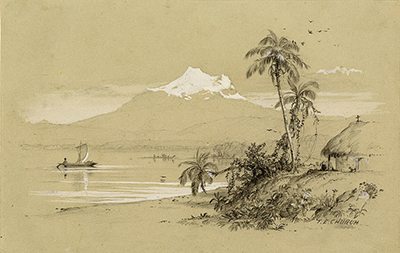Frederic Edwin Church went on frequent trips with his tutor, Thomas Cole around the North American landscape during their years of study. Typically they would spend their time making detailed sketches of any beautiful landscapes that they came across as they moved from location to location.
There remains a large collection of drawings from the career of Frederic Edwin Church, in a variety of levels of completeness. Many were intended purely as study sketches in order to develop the artist's eye and also his skills as a draughtsman. Some study pieces were also completed with the intention of allowing the artist to work from these at a later date, normally once he had returned to his warm studio where all his necessary tools would be accessible. This was the practice used by most members of the Hudson River School, including Thomas Cole who likely would have taught his student about the merits of working in this way. Church himself worked predominantly with graphite sticks, before adding touches of white gouache at the end as if to highlight the key elements of the landscape.
The drawing shown in this page is a beautiful charcoal piece titled, Magdalena River, New Granada, Equador, 1853 and again the artist finishes it off with the highlighting of white gouache. The drawings that we have left from his career tend to be very consistent with this format, only varying the colour of paper from time to time. It is likely that the latter would have been dictated by whichever sketchbook he had taken with him on each trip, meaning each location would have used the same paper each time. In other examples the artist would go further and incorporate some brushstrokes on top of his earlier drawn lines. These, again, would vary in amount of work, sometimes purely as experiments, whilst other times the finished result would be intended as a presentable artwork in its own right.
Many drawings that we have uncovered from Church's career focus on specific elements of a scene, leaving much of the rest fairly sparse. In some cases he would produce extraordinary detail of foliage in the foreground and then leave most of the rest of the composition untouched. In other examples, particularly during his travels around Europe, he might concentrate entirely on an element of architecture and just develop his understanding of its shapes and balance of light. In the case of his trips abroad and work with ancient sculpture and architecture, many of these shapes and experiences were new to him having previously only been concerned with the natural sights and sounds of the North American landscape.
The art of drawing was undervalued for many centuries within European art history, with even the likes of Michelangelo's studies of the human anatomy being seen purely as supporting pieces for later paintings and sculptures. The same can be said for landscape paintings too, with other genres being far more respected and sought after during the Renaissance and Baroque periods. This has changed in recent centuries, though, with many exhibitions focusing entirely on artist's work with graphite and pastels. There has also been a greater attempt to preserve the drawings of great artists, when previously these fragile supporting pieces were not deemed valuable, both financially and also artistically.




